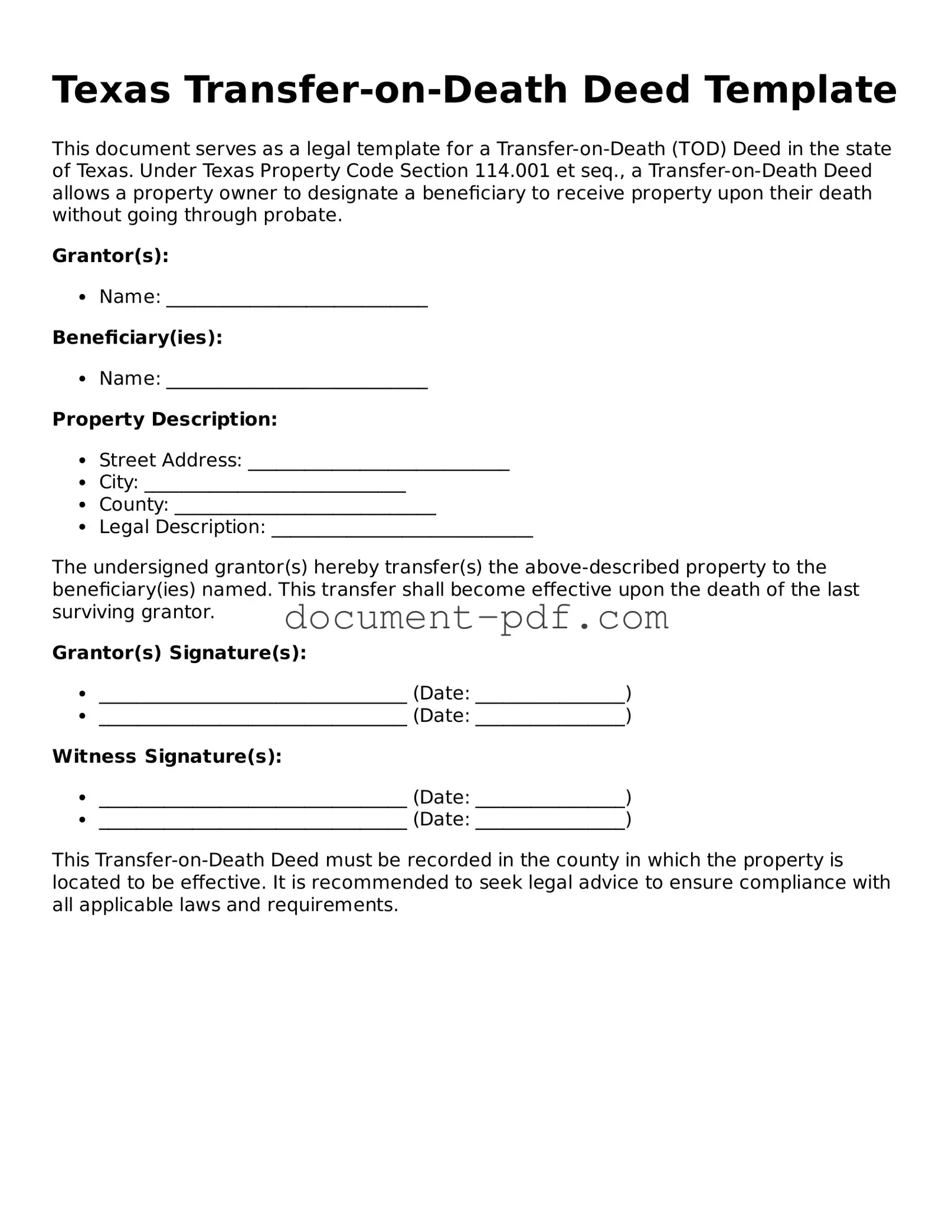The Texas Transfer-on-Death Deed (TODD) allows individuals to transfer real estate to beneficiaries upon their death without the need for probate. This document is similar to a will in that both serve to dictate how assets are distributed after one’s passing. However, a key difference lies in the fact that a will requires probate, which can be a lengthy and costly process. In contrast, a TODD bypasses probate entirely, allowing for a more straightforward transfer of property directly to the named beneficiaries. This simplicity can be appealing for those looking to streamline the process of passing on their real estate holdings.
Another document that shares similarities with the TODD is a living trust. Like a TODD, a living trust allows individuals to manage their assets during their lifetime and specify how those assets should be distributed upon their death. The primary distinction is that a living trust can include various types of assets, not just real estate. Additionally, assets placed in a living trust can avoid probate, providing a level of privacy and efficiency that many find advantageous. However, setting up a living trust may require more time and legal assistance compared to a TODD.
A beneficiary deed is also comparable to the TODD. This document allows property owners to designate a beneficiary who will inherit their property upon their death. Similar to the TODD, a beneficiary deed avoids probate, making the transfer process smoother for heirs. The main difference lies in the terminology and specific legal requirements of each document, which can vary by state. However, both serve the same purpose of facilitating the transfer of real estate outside of the probate system.
The life estate deed shares some characteristics with the TODD as well. A life estate deed allows an individual to retain the right to live in a property during their lifetime while designating a remainder beneficiary who will inherit the property after their death. While both documents facilitate the transfer of property, a life estate deed grants certain rights to the grantor during their lifetime, which is not the case with a TODD. This distinction is important for individuals considering their control over the property while they are still alive.
A joint tenancy deed also resembles the TODD in that it allows for the transfer of property upon death. In a joint tenancy arrangement, two or more individuals hold title to a property together, with the right of survivorship. This means that when one owner passes away, their share automatically transfers to the surviving owner(s). While both the joint tenancy deed and the TODD avoid probate, the joint tenancy deed requires the presence of multiple owners, which may not be suitable for everyone.
To ensure you're well-protected, consider drafting a "comprehensive Hold Harmless Agreement" that clarifies liability responsibilities and safeguards your interests in various transactions. For more information, you can visit the following link: Hold Harmless Agreement.
Power of attorney documents also have a connection to the TODD, particularly in how they allow individuals to designate someone to manage their affairs. A power of attorney grants authority to another person to make decisions on behalf of the individual, including decisions related to property. However, a power of attorney ceases to be effective upon the death of the individual, while a TODD continues to operate beyond death, transferring property directly to beneficiaries.
Another document that aligns with the principles of the TODD is the irrevocable trust. This type of trust allows individuals to place assets into the trust and designate beneficiaries who will receive those assets upon the grantor's death. The irrevocable nature of this trust means that once assets are transferred, the grantor cannot reclaim them. While both the irrevocable trust and the TODD facilitate the transfer of assets outside of probate, the irrevocable trust may offer additional benefits in terms of tax planning and asset protection.
Lastly, a payable-on-death (POD) account is similar in function to the TODD, as it allows for the transfer of funds upon the account holder's death. A POD account designates a beneficiary who will receive the funds directly without going through probate. While this document pertains to financial assets rather than real estate, it embodies the same principle of simplifying the transfer process and ensuring that beneficiaries receive their inheritance quickly and efficiently.
